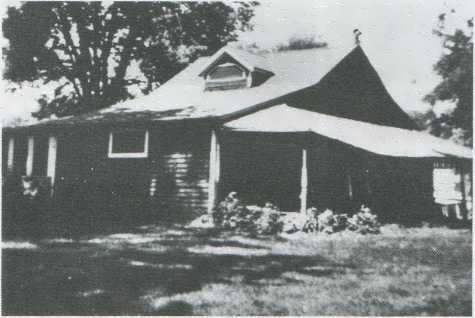Hamburger was 5 lbs. for $1.00. A hamburger and cup of coffee in a restaurant was 25 cents. A hair cut and shave cost 25 cents. It cost 2 cents for a postage stamp to mail a letter; postcards cost 1 cent. Gasoline was $1.00 for 5 gals. - sometimes 6 gals.
In each home the telephone hung on the wall and was cranked by hand. There were no private telephone lines in the early 1900’s. Everyone was on a “party line”. Each family on the party line was assigned a different combination of long and short rings. (Our’s was one short and one long ring.) When the telephone rang, anyone on the party line could (and often did) pick up their telephone to hear the news.

Henry and Hannah Isabell (Nelson) Forde May 23, 1915
In 1942 Henry had a farm sale and rented the farm to a neighbor. Henry was not old enough for a pension, so he worked for a year at the Herculease Powder Company In Baraboo, Wl. In 1944 he came back to Decorah and worked for the city until 1945. Henry then moved to the Coon Club Cabin in Pleasant Twp. where he lived until illness forced him to enter a nursing home. He died 8 Mar 1953 of cancer. He is buried at the Canoe Ridge Lutheran Church Cemetery, rural Decorah.
Forde, Per and Guri (Nasen)
(Hazel Smorstad)
Per Jonson Forde was born 1 May 1813 in Voss, Norway. He married Guri Andersdtr Nasen (b. 1812) 17 Feb 1840 in Norway. Per died 18 Sep 1898; Guri died 10 Mar 1892. Both are buried in the Big Canoe Lutheran Church Cemetery, rural Decorah.
When Per’s father died, by tradition, his farm was inherited by his oldest son. This was Per’s brother, Ola Jonson Forde. This left Per with no land or home. Land was scarce in Norway. The rich clergy had bought up all the available land. They then rented small parcels of land to the poor peasants at very high prices. In 1841 Per rented a small piece of land with a house from Nils
Olavson Stolheim for 900 specidollar. This place was called Senji. He stayed on this place for 12 years. In addition to the 900 specidollar, he was to give the owner half of what the family raised and half of the manure. The manure was to be spread on the owner’s fields. Per also had to pay 2 specidollar to the Voss court each fall. This was a tax on his animals. Per farmed with oxen. In addition to plowing, planting, and harvesting the grain, Per had to work in the timber. The owner got half of the wood he cut. In 1853 Per sold his possessions and left for America. His possessions included a saw mill which he sold to his brother Ola Jonson Forde.
On 25 Apr 1853 Per, Guri and their six children left Bergan, Norway for America on the ship Vergo. The sea voyage took 6 1/2 weeks. They arrived in Canada in June and spent a week in quarantine. The next leg of the journey took them from Canada to Koshkonong, Wl. They first traveled to New York City by canal boat. From New York City they went to Poughkeepsie, NY; Buffalo, NY; Toledo, OH; Chicago, IL; Milwaukee, Wl; Jefferson, Wl; and finally, Koshkonong. This part of the trip took 13 days.
Per and Guri stayed in Koshkonong for a year. During this time they worked to pay off their passage to America and to save money to buy food for the trip to Iowa. The trip to America cost $25.00 for each adult and half fare for children under twelve. While in Koshkonong their seventh child, Halvor P Forde, was born. He was baptized 1 Jan 1854 in Koshkonong.
The trip from Koshkonong to Decorah took 8 days. They traveled through Spring Prairie, Madison and Dodgeville to Prairie du Chien, Wl. Per and Guri crossed the Mississippi River on a hand operated ferry to McGregor, IA. They then traveled by lumber wagon and oxen to Washington Prairie and Decorah. In Decorah there was no bridge across the Oneota River (now the Upper Iowa River), so they had to ford the river. The water was so deep it came up into the wagon box and some of the supplies were lost. From Decorah Per and his family traveled to his brother, Halvor J. Forde’s home northeast of Decorah in Pleasant Twp. Halvor had come to America in 1849 and to Iowa in 1851.

Coon Club Cabin, first home of Guri Forde built in 1851. Per J. Forde bought this home in 1856.
F-24
Complete OCR transcription.
See the associated scan to compare with the published information.


